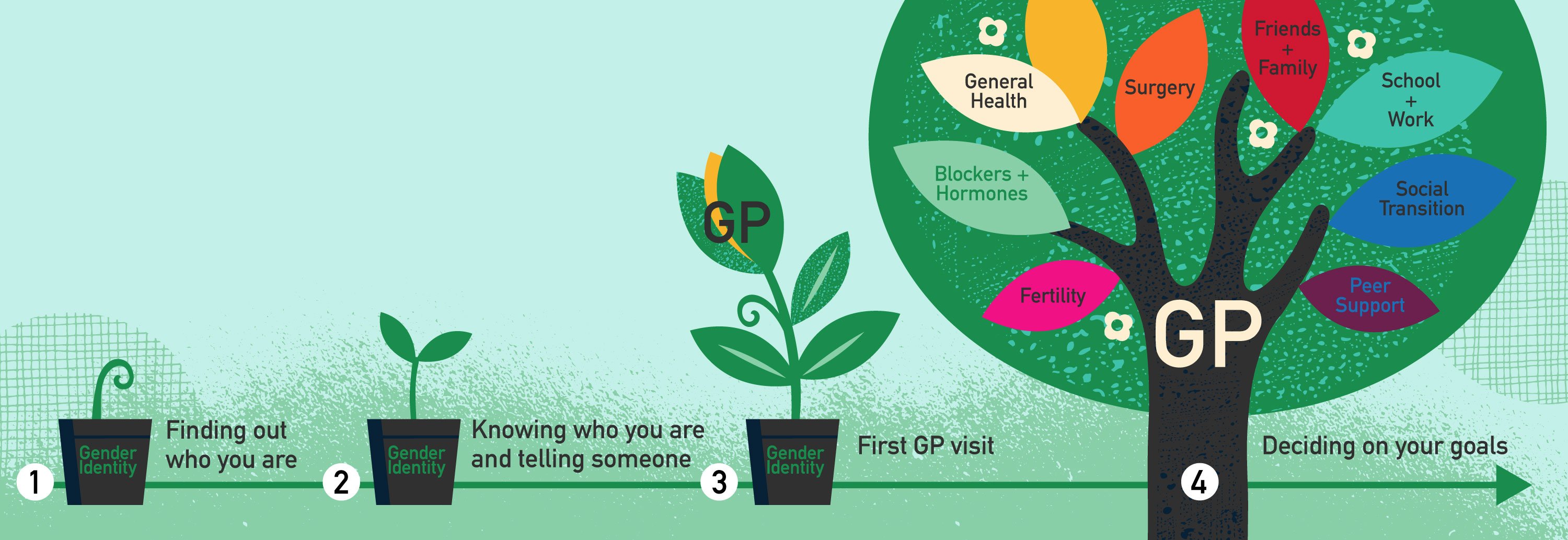What is gender diversity? What support is there? How can your GP and hospital doctors help you?
Our team has made a printable letter for your GP that you can fill and take to your appointment to help you talk about what you would like to happen next. This letter also explains how to organize an appointment to see our paediatric, adolescent or adult doctors if you would like to arrange a visit. Click on the links below to find the resources helpful for you.
Our local community and health professionals have made these information sheets for parents of children, teenagers and young adults. Click on the links below to find the resources helpful for you.
Resources you will need
Parents and children
When your child was born, they were given a gender based on their physical appearance. This gender was listed on their birth certificate as their legal sex classification.
Some children grow up feeling that their given gender doesn’t match their gender identity - who they truly are on the inside.
Feeling different is not easy, but there is nothing ‘wrong’ with your child. About 1 in 150 people are gender diverse (or transgender). Your child may feel like the ‘opposite’ gender, between genders or experience their gender in a way that is unique to them.
Your GP is your first point of call for your child’s healthcare. Your GP will talk to you about your child’s health, how you and your child are feeling. Your GP will give you a referral for a paediatrician who has experience caring for young people who don’t believe the gender they were given is right for them.
Print this sheet out and take it to your child's GP appointment: GP appointment resource for a child
Information resource for parent and children: Transgender Health: Information sheet for children
Older children and teenagers
When you’re born, you are given a gender based on the appearance of your penis (male) or vagina (female). Some people grow up feeling that their given gender (male or female) doesn’t match who they truly are on the inside. If you feel you were assigned a gender that isn’t true to who you are, you are not alone.
You may feel like the ‘opposite’ gender, between genders or in a way unique to you. And, just like everyone else, you may be attracted to girls, boys, both or neither. What matters is that you remain true to how you feel and continue to ask for help – especially if you feel uncomfortable or distressed by the gender you were given.
Your GP is your first point of call for your healthcare, and you can see your GP with or without your parents. Your GP will talk to you about your health, how you’re feeling and if you want support to take steps to change how you look. Your GP will help you find out about your options.
Print this sheet out and take it to your GP appointment: GP appointment resource for adolescents
Information resource for adolescents: Transgender Health: Information sheet for adolescents
Young adults
When you’re born, you are given a gender based on the appearance of your genitals (for most people, a penis or vagina). Some people grow up feeling that their given gender (male or female) doesn’t match their gender identity - who they truly are on the inside.
If you feel you were assigned a gender that isn’t true to who you are, you are not alone.
Feeling different is not easy, but there is nothing ‘wrong’ with you. About 1 in 150 people are transgender.
Your GP is your first point of call for your healthcare. Your GP will talk to you about your health, how you’re feeling and if you want support to take steps to change your body to reflect your gender identity. Your GP will help you find out about your options.
Your GP should talk to you about your health openly and honestly. If you feel like your GP doesn’t understand what you’re going through, it’s okay to change GPs. Contact the support groups to find a trans-friendly GP.
Print this sheet out and take it to your GP appointment: GP appointment resource for young adults
Information resource for adolescents: Transgender Health: Information sheet for young adults
Some helpful videos for your journey
It's a process
A series of firsts
Having support networks
Information for parents
Natalie & Taylor's journey
Standards of care
NSW Health is committed to providing evidence-based, holistic, age-appropriate and developmentally informed care for trans and gender diverse young people. To enhance existing services, NSW Health is developing a coordinated, statewide Specialist Trans and Gender Diverse Health Service (TGD Health Service) to provide gender affirming care for people aged under 25.
The TGD Health Service will be delivered through two specialist hubs. The Rural and Regional Hub was established in March 2021 at Maple Leaf House by Hunter New England Local Health District. The Sydney Metropolitan Hub is currently under development and will be delivered at two sites. Sydney Children’s Hospitals Network will provide support at The Children’s Hospital at Westmead for young people under 16, and South Eastern Sydney Local Health District will support young people aged 16 and over at a new community-based site. There will be a seamless care pathway for adolescents and young adults between the two sites.
The scope of the Hubs is limited to specialist trans and gender diverse health care. The Hubs work closely with existing support services to provide holistic care for young people and their families and carers.
For further information regarding how the TGD Health Service will operate and deliver services, including responses to some Frequently Asked Questions, please visit https://www.health.nsw.gov.au/lgbtiq-health/Pages/TGD-Health-Service.aspx.
Gender forest
We are all part of the biodiverse gender forest. Every tree is different. We can label the trees but they are just that.....labels.

Illustration: ©Jane Coffey

